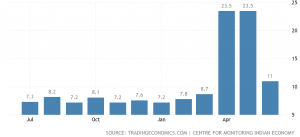By Stuart Burns
India faces a dilemma - the country has the second-highest coronavirus caseload in the world at 4.2 million people and its economy is struggling.
India overtook Brazil this week, as it reported a record 90,000+ new cases on Saturday and nearly 92,000 on Sunday.
Yet, despite surging infections, India desperately needs to get its economy working again. It will need to do so in order to avoid the brutal impact of unemployment and rising poverty.
Debt approaches highest level in four decades as India's economy struggles
According to The New York Times, the government's tax revenues have plummeted. Some states are unable to pay healthcare workers and government debt is approaching its highest level in 40 years.
As the below graph from Trading Economics shows, unemployment soured in the spring following the government's ill-fated lockdown March 24:

The recovery has been swift but far from complete. Tens of millions of migrant workers, for example, are reluctant to return from the countryside to the cities.
As the New York Times explains, the lockdown was announced with just four hours' notice. Offices, factories, trains, roads and even the borders between states were closed.
Instantly, tens of millions of Indians lost their jobs. Facing potential starvation, many began streaming back to their homes in the countryside, often by foot, in an epic migration of biblical proportions.
In the process, they spread the virus to every corner of the country and within touching distance of all 1.3 billion people.
Back to work?
As the unemployment figures show, some businesses are getting back to work despite the rising infection rates. The authorities are trying to contain local outbreaks while limiting a nationwide surge, but it is a juggling act they appear to be losing.
Workers remain reluctant to go back